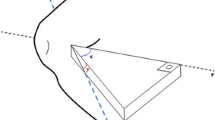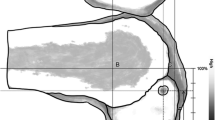Abstract
Purpose
The purpose of the present study was to assess the risk of femoral tunnel collisions between the medial collateral ligament (MCL) and the posterior cruciate ligament (PCL) tunnels during a simultaneous PCL and MCL reconstruction.
Methods
Fourth generation medium and large synthetic femur bones were used. On each femur, a MCL tunnel and a PCL tunnel were reamed. The MCL tunnel was drilled at 0°, 20° and 40° of axial and coronal angulations. The PCL femoral tunnel was reamed to simulate two different tunnel directions that could be obtained through an inside-out and outside-in technique. Tunnels were filled with epoxy resin augmented with BaSO4, and a multidetector CT examination of each specimen was performed.
Results
High rate of tunnel collision (62.5 %) was found when the MCL femoral tunnel was reamed with a coronal angulation of 0° and 20°. The rate of tunnel collision significantly decreased (0 %) when the MCL tunnel was reamed proximally with a coronal angulation of 40°. No differences were found between the two PCL tunnel directions in terms of tunnel collision.
Conclusion
The results of this study can help surgeons to better direct the femoral MCL tunnel in order to avoid a collision between femoral tunnels during a combined MCL and PCL reconstruction. In order to minimize such potential complications, the MCL tunnel should be created limiting the axial angulation and it should be drilled with a proximal angulation from 20° to 40°, depending on the medial condyle width.





Similar content being viewed by others
References
Bergfeld JA, Graham SM, Parker RD, Valdevit AD, Kambic HE (2005) A biomechanical comparison of posterior cruciate ligament reconstructions using single- and double-bundle tibial inlay techniques. Am J Sports Med 33:976–981
Bin SI, Nam TS (2007) Surgical outcome of 2-stage management of multiple knee ligament injuries after knee dislocation. Arthroscopy 23:1066–1072
Camarda L, D’Arienzo M, Patera GP, Filosto L, LaPrade RF (2011) Avoiding tunnel collisions between fibular collateral ligament and ACL posterolateral bundle reconstruction. Knee Surg Sports Traumatol Arthrosc 19:598–603
Coobs BR, Wijdicks CA, Armitage BM et al (2010) An in vitro analysis of an anatomical medial knee reconstruction. Am J Sports Med 38:339–347
Edson CJ (2006) Conservative and postoperative rehabilitation of isolated and combined injuries of the medial collateral ligament. Sports Med Arthrosc 14:105–110
Ellsasser JC, Reynolds FC, Omohundro JR (1974) The non-operative treatment of collateral ligament injuries of the knee in professional football players. An analysis of seventy-four injuries treated non-operatively and twenty-four injuries treated surgically. J Bone Joint Surg Am 56:1185–1190
Frolke JP, Oskam J, Vierhout PA (1998) Primary reconstruction of the medial collateral ligament in combined injury of the medial collateral and anterior cruciate ligaments. short-term results. Knee Surg Sports Traumatol Arthrosc 6:103–106
Gelber PE, Erquicia JI, Sosa G et al (2013) Femoral tunnel drilling angles for the posterolateral corner in multiligamentary knee reconstructions: computed tomography evaluation in a cadaveric model. Arthroscopy 29:257–265
Hammoud S, Reinhardt KR, Marx RG (2010) Outcomes of posterior cruciate ligament treatment: a review of the evidence. Sports Med Arthrosc 18:280–291
Harner CD, Baek GH, Vogrin TM, Carlin GJ, Kashiwaguchi S, Woo SL (1999) Quantitative analysis of human cruciate ligament insertions. Arthroscopy 15:741–749
Indelicato PA (1983) Non-operative treatment of complete tears of the medial collateral ligament of the knee. J Bone Joint Surg Am 65:323–329
Johannsen AM, Anderson CJ, Wijdicks CA, Engebretsen L, LaPrade RF (2013) Radiographic landmarks for tunnel positioning in posterior cruciate ligament reconstructions. Am J Sports Med 41:35–42
Kannus P (1988) Long-term results of conservatively treated medial collateral ligament injuries of the knee joint. Clin Orthop Relat Res 226:103–112
Kim SJ, Lee DH, Kim TE, Choi NH (2008) Concomitant reconstruction of the medial collateral and posterior oblique ligaments for medial instability of the knee. J Bone Joint Surg Br 90:1323–1327
Laprade RF, Wijdicks CA (2012) Surgical technique: development of an anatomic medial knee reconstruction. Clin Orthop Relat Res 470:806–814
Li B, Wang JS, He M, Wang GB, Shen P, Bai LH (2014) Comparison of hamstring tendon autograft and tibialis anterior allograft in arthroscopic transtibial single-bundle posterior cruciate ligament reconstruction. Knee Surg Sports Traumatol Arthrosc. doi:10.1007/s00167-014-3267-z
Lind M, Jakobsen BW, Lund B, Hansen MS, Abdallah O, Christiansen SE (2009) Anatomical reconstruction of the medial collateral ligament and posteromedial corner of the knee in patients with chronic medial collateral ligament instability. Am J Sports Med 37:1116–1122
Makris CA, Georgoulis AD, Papageorgiou CD, Moebius UG, Soucacos PN (2000) Posterior cruciate ligament architecture: evaluation under microsurgical dissection. Arthroscopy 16:627–632
Mejia EA, Noyes FR, Grood ES (2002) Posterior cruciate ligament femoral insertion site characteristics. importance for reconstructive procedures. Am J Sports Med 30:643–651
O’Brien SJ, Warren RF, Pavlov H, Panariello R, Wickiewicz TL (1991) Reconstruction of the chronically insufficient anterior cruciate ligament with the central third of the patellar ligament. J Bone Joint Surg Am 73:278–286
Race A, Amis AA (1998) PCL reconstruction. In vitro biomechanical comparison of ‘isometric’ versus single and double-bundled ‘anatomic’ grafts. J Bone Joint Surg Br 80:173–179
Reider B, Sathy MR, Talkington J, Blyznak N, Kollias S (1994) Treatment of isolated medial collateral ligament injuries in athletes with early functional rehabilitation. A five-year follow-up study. Am J Sports Med 22:470–477
Tompkins M, Keller TC, Milewski MD et al (2013) Anatomic femoral tunnels in posterior cruciate ligament reconstruction: inside-out versus outside-in drilling. Am J Sports Med 41:43–50
Treme G, Diduch DR, Billante MJ, Miller MD, Hart JM (2008) Hamstring graft size prediction: a prospective clinical evaluation. Am J Sports Med 36:2204–2209
Weimann A, Schatka I, Herbort M et al (2012) Reconstruction of the posterior oblique ligament and the posterior cruciate ligament in knees with posteromedial instability. Arthroscopy 28:1283–1289
Wiley WB, Askew MJ, Melby A III, Noe DA (2006) Kinematics of the posterior cruciate ligament/posterolateral corner-injured knee after reconstruction by single- and double-bundle intra-articular grafts. Am J Sports Med 34:741–748
Wijdicks CA, Griffith CJ, LaPrade RF et al (2009) Radiographic identification of the primary medial knee structures. J Bone Joint Surg Am 91:521–529
Yoshiya S, Kuroda R, Mizuno K, Yamamoto T, Kurosaka M (2005) Medial collateral ligament reconstruction using autogenous hamstring tendons: technique and results in initial cases. Am J Sports Med 33:1380–1385
Yue B, Varadarajan KM, Ai S, Tang T, Rubash HE, Li G (2011) Differences of knee anthropometry between Chinese and white men and women. J Arthroplast 26:124–130
Conflict of interest
The authors declare that they have no conflict of interest related to the publication of this manuscript.
Author information
Authors and Affiliations
Corresponding author
Rights and permissions
About this article
Cite this article
Camarda, L., Grassedonio, E., Lauria, M. et al. How to avoid collision between PCL and MCL femoral tunnels during a simultaneous reconstruction. Knee Surg Sports Traumatol Arthrosc 24, 2767–2772 (2016). https://doi.org/10.1007/s00167-014-3446-y
Received:
Accepted:
Published:
Issue Date:
DOI: https://doi.org/10.1007/s00167-014-3446-y




